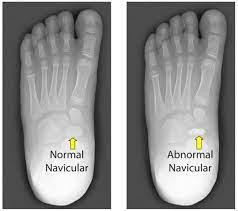Kohler’s Disease in Children: Causes, Symptoms, Treatment, and Recovery
Kohler’s disease is a rare pediatric foot condition that primarily affects the navicular bone, located within the midfoot. It typically occurs in children between the ages of 3 and 5. This condition results from a temporary loss of blood supply to the navicular bone, leading to its deterioration and causing pain and discomfort.
This article explores the symptoms, causes, diagnosis, treatment options, potential complications, and recovery associated with Kohler’s disease in children.
Symptoms of Kohler’s Disease
The most common symptoms of Kohler’s disease in children include pain and tenderness in the top and inner areas of the foot, particularly around the midfoot. These symptoms often begin gradually and are not typically triggered by an initial injury.
Swelling may also occur, and affected children may develop a noticeable limp or experience difficulty bearing weight on the affected foot. The intensity of pain can vary and may worsen with activity or prolonged standing.
Causes and Risk Factors of Kohler’s Disease
The precise cause of Kohler’s disease remains unclear, but it is thought to result from a disruption in the blood supply to the navicular bone, leading to temporary damage.
This condition predominantly affects boys, and it frequently occurs during growth spurts.
Diagnosis and Treatment Options
Podiatrists diagnose Kohler’s disease through a comprehensive assessment that includes a physical examination, a review of the patient’s medical history, and imaging tests, such as X-rays. X-rays can reveal changes in the affected navicular bone, such as reduced density or irregularities.
The treatment of Kohler’s disease primarily focuses on pain management and facilitating healing. In most cases, conservative measures prove effective. These include rest, limiting weight-bearing activities, and using supportive footwear or orthotic devices.
Pain relief can be achieved with over-the-counter pain medications or anti-inflammatory drugs as recommended by healthcare professionals. In rare instances where severe pain or persistent symptoms persist, a short leg cast or walking boot may be prescribed to immobilize the foot and facilitate healing.
Potential Complications
Kohler’s disease generally resolves over time, with most children experiencing a full recovery without long-term complications. However, in some cases, a slight difference in the size or shape of the affected foot compared to the unaffected one may occur.
Regular follow-up appointments with a podiatrist can help monitor the condition and address concerns regarding foot deformities or abnormalities.
Managing Pain and Discomfort
Parents can support their children by encouraging rest and minimizing activities that exacerbate symptoms. The application of ice packs to the affected area for short intervals can help alleviate pain and reduce swelling. Ensuring that children wear comfortable and supportive footwear is essential to reduce pressure on the foot.
If necessary, cushioned insoles or orthotics can provide additional support and alleviate pressure on the affected area.
Can Kohler’s Disease be Prevented?
Since the exact cause of Kohler’s disease is not known, there are no specific preventive measures to avoid its occurrence. However, maintaining a healthy lifestyle, including a balanced diet and regular exercise, can contribute to overall foot health. Ensuring that children wear properly fitted shoes with adequate support can also help reduce the risk of foot-related conditions in general.
How Long Does Kohler’s Disease Last?
The duration of Kohler’s disease varies from child to child. In most cases, symptoms gradually improve over several months to a year as the navicular bone heals and blood supply is restored.
Severe pain often lasts only a few months. Full recovery is expected as the child continues to grow and develop, with regular check-ups with a podiatrist to monitor progress and ensure proper healing.
Rehabilitation and Physical Therapy for Kohler’s Disease
Rehabilitation exercises or physical therapy may be recommended to aid in recovery. These exercises focus on improving foot strength, flexibility, and range of motion. Stretching exercises for calf muscles and gentle foot exercises can help restore normal foot function and prevent muscle tightness.
A qualified podiatrist or physical therapist can provide guidance. However, pain management and protective measures, such as orthotics, are more common treatment approaches.
If your child has foot pain, call Hurst Podiatry today
Kohler’s disease is a relatively rare condition that affects the navicular bone in children, causing pain and discomfort in the foot. While it can be concerning for parents, the good news is that most cases resolve on their own over time, with children experiencing a full recovery.
Seeking professional help from a trusted podiatry clinic like Hurst Podiatry is essential in managing and treating Kohler’s disease. Our experienced podiatrists will accurately diagnose the condition through thorough examinations and imaging tests. We can provide personalised treatment plans tailored to each child’s specific needs, ensuring proper pain management and promoting healing.
Remember, if your child experiences symptoms of Kohler’s disease or any other foot-related issues, don’t hesitate to reach out to Hurst Podiatry. Our expertise and dedication to pediatric foot health will provide the care and support needed for your child’s optimal recovery.





